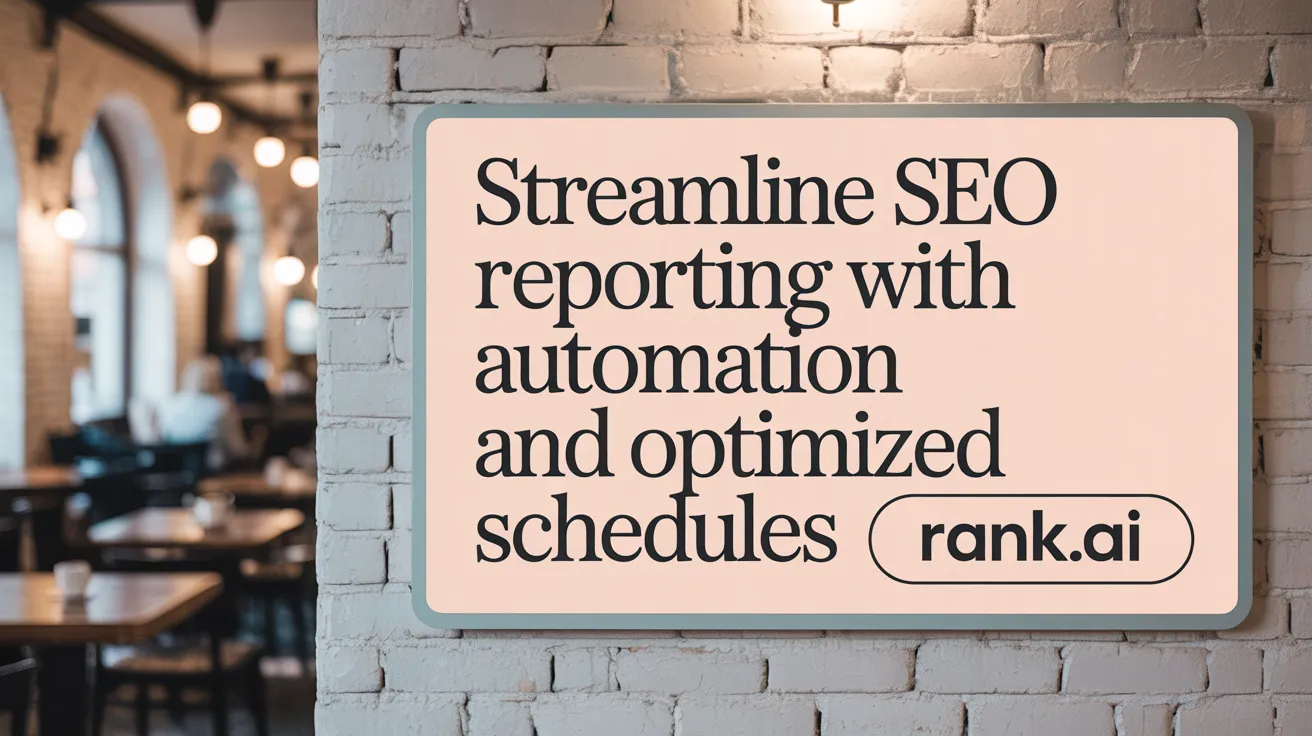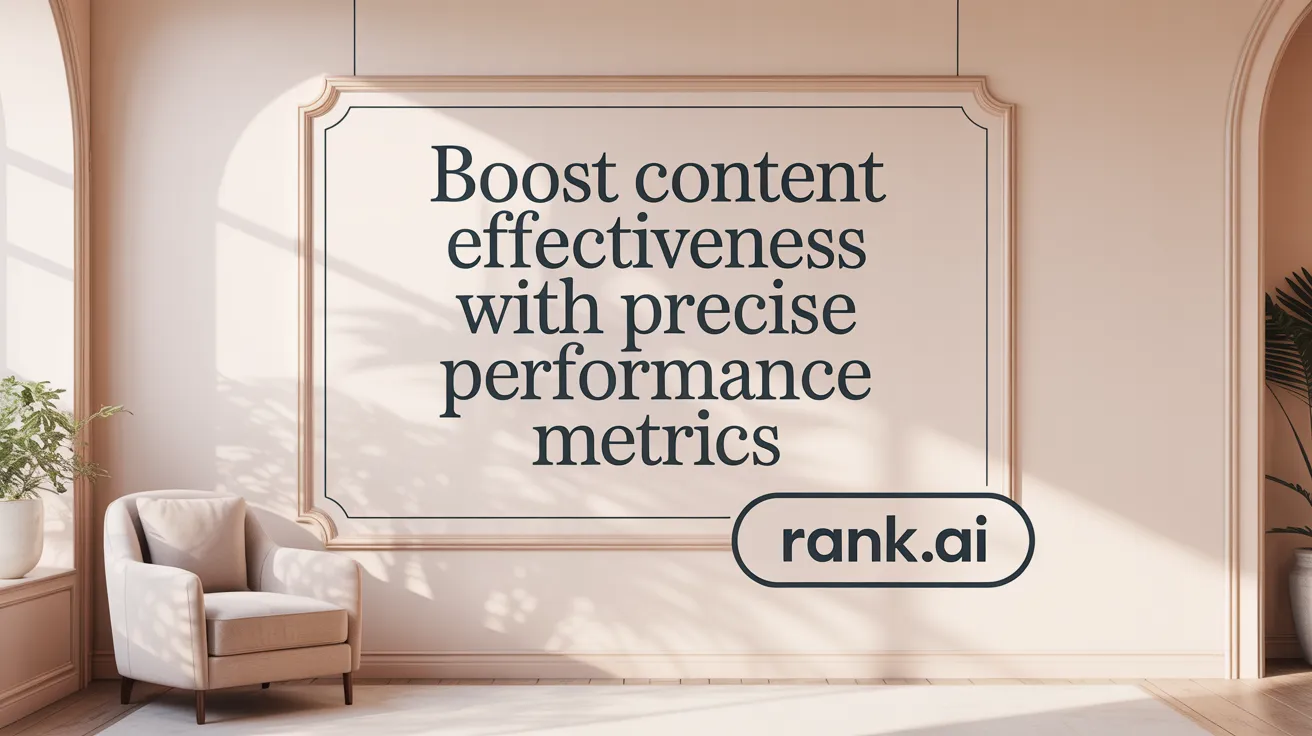Advanced SEO Reporting Techniques for Performance Tracking
Mastering SEO Reporting for Strategic Growth and Performance

Unlocking the Power of Advanced SEO Reporting
In the evolving landscape of digital marketing, advanced SEO reporting and performance tracking have become essential for businesses aiming to maximize their online visibility and return on investment. This comprehensive guide explores sophisticated techniques, key metrics, and powerful tools that enable marketers to track SEO success accurately, analyze performance data effectively, and communicate insights clearly. By integrating robust analytics platforms, harnessing automation, and adopting data-driven strategies, organizations can fine-tune their SEO efforts to stay competitive and achieve sustained growth.
How to Track SEO Performance: SEO Metrics that Actually ...
Discover how to effectively track your SEO performance by focusing on the metrics that truly matter. In this guide, we will explore key ...
Understanding Key Metrics and KPIs in SEO Performance Measurement
What are the key metrics and KPIs used to measure SEO success?
Tracking SEO performance effectively requires focusing on several vital metrics and Key Performance Indicators (KPIs).
One of the most fundamental indicators is organic traffic, which measures the number of visitors arriving from unpaid search engine results. This metric serves as a primary visibility indicator, reflecting how well your site ranks for relevant keywords.
Keyword rankings are crucial for understanding search visibility. Monitoring your position for targeted keywords helps identify opportunities and track improvements over time.
The click-through rate (CTR) is a compelling metric that indicates the effectiveness of your search snippets in attracting clicks. Higher CTR generally means your listings are relevant and appealing.
User engagement metrics such as bounce rate (the percentage of visitors leaving after viewing only one page) and dwell time or session duration inform you about content relevance and user experience.
Conversion rates measure the ability of your SEO efforts to generate desired business actions—such as form submissions, sales, or sign-ups—making them essential for assessing ROI.
Backlinks, especially their quantity and quality, influence your website's authority and ranking potential. Tools like Semrush, Majestic, and Moz help monitor backlink profiles.
Domain authority and trust flow scores, often provided by Moz or Majestic, offer predictions on your site's likelihood to rank high and its overall credibility.
Website performance is also critical. Metrics like page load speed and Core Web Vitals are significant ranking factors that impact user experience and SEO success.
User engagement metrics like dwell time and session duration help understand how valuable and engaging your content is for visitors.
Finally, evaluating cost-related metrics such as Cost Per Acquisition (CPA), Return on Investment (ROI), and traffic cost allows businesses to measure the profitability of their SEO campaigns.
Effective monitoring involves using tools like Google Search Console and Semrush, which provide insights into impressions, position fluctuations, and overall search visibility.
By consistently analyzing these metrics, marketers can make informed decisions, optimize strategies, and improve overall SEO performance.
Techniques and Strategies for Advanced SEO Reporting and Tracking

What techniques and strategies can be used for advanced SEO reporting and performance tracking?
Effective advanced SEO reporting involves leveraging a suite of sophisticated tools like Google Search Console, Google Analytics, SEMrush, Ahrefs, and Moz to collect in-depth data on keyword rankings, organic traffic, backlinks, and user engagement.
Integrating artificial intelligence and machine learning enhances predictive analytics, enabling SEO professionals to identify potential ranking opportunities and anticipate algorithm impacts before they happen. Automated alerts for significant changes in rankings, traffic, or technical issues ensure quick responses to maintain search visibility.
Segmenting data—such as differentiating between brand versus non-brand searches, transactional versus informational queries, or device-specific traffic—refines targeting strategies and helps tailor content and optimization efforts for specific audience segments.
Automation tools play a vital role in streamlining data collection and report generation. Platforms like Google Data Studio, DashThis, and custom dashboards enable the creation of real-time, visually appealing reports that can be scheduled and shared automatically, reducing manual effort.
Monitoring major events like algorithm updates, site modifications, and competitor activities provides critical insights for strategic adjustments. Tracking SEO-specific issues through log file analysis and technical audits ensures crawlability and indexability remain optimal.
Advanced techniques such as topic clustering—grouping related content for better topic authority—and implementing structured data enhance search presence and featured snippet opportunities.
Focusing on conversion metrics, including micro-conversions and revenue attribution, shifts the emphasis from vanity rankings to actual business results. Incorporating SERP feature tracking (e.g., snippets, images, local packs) allows for measuring visibility across diverse search formats.
By combining these strategies, SEO teams can achieve a comprehensive view of performance, anticipate changes, and tailor tactics to maximize organic growth—offering stakeholders meticulous insights into ROI and long-term success.
Leveraging SEO Analytics Tools for In-Depth Performance Insights
When it comes to analyzing, reporting, and monitoring SEO efforts, selecting the right combination of tools is crucial. Comprehensive platforms like SEMrush, Ahrefs, and Moz are among the most effective for gaining detailed insights into keyword rankings, backlink profiles, and overall domain authority. These all-in-one solutions enable marketers to track performance across multiple metrics and competitors, making strategic decisions more data-driven.
In addition to these platforms, Google Analytics and Google Search Console form the backbone of SEO performance tracking. Google Analytics offers vital data on user behavior, traffic sources, conversions, and engagement metrics, while Search Console provides search visibility data, indexing status, and click-through rates. Together, they allow for a holistic view of how a website is performing in organic search.
For technical SEO and site health audits, tools such as Screaming Frog, SEO PowerSuite, and Sitechecker are indispensable. Screaming Frog is renowned for crawling large sites to identify SEO issues like broken links, duplicate content, and page speed problems. SEO PowerSuite offers comprehensive auditing, while Sitechecker provides real-time site analysis, Core Web Vitals assessments, and visibility reports.
Customizable reporting tools like Swydo and Google Data Studio further enhance SEO analytics by enabling tailored dashboards and automated reports. These tools help aggregate data from various sources, creating visualizations that are easy to interpret for clients and team members. Automated reporting streamlines the process, saves time, and supports proactive SEO management.
Integrating these tools within an efficient workflow allows marketers to monitor website health, identify and resolve issues swiftly, and refine strategies based on ongoing performance data. Local SEO features in specialized tools ensure that businesses optimize their presence in local searches by tracking local pack rankings, citation consistency, and Google My Business insights.
Finally, creating dashboards with clear visualizations is essential for effective communication. These dashboards serve as central hubs for ongoing monitoring and reporting to clients, making complex data accessible and actionable. The combination of broad platform insights and detailed technical analysis ensures a comprehensive understanding of SEO performance, ultimately driving better results in today’s competitive digital landscape.
Best Practices for Creating Effective SEO Reports and Data Presentation
Creating impactful SEO reports requires a focus on clarity, conciseness, and visual engagement to ensure stakeholders can easily interpret complex data. Using dashboards, graphs, and infographics transforms raw SEO metrics into digestible visual stories, enabling quick insights into performance trends. Essential KPIs to highlight include organic traffic, keyword rankings, backlinks, content performance, technical health, and conversion rates, all customized to match the specific interests and understanding level of your audience.
Tailoring reports to meet business objectives enhances relevance. For example, an e-commerce site may focus on organic revenue and transaction metrics, while a local business might prioritize local rankings and Google Business Profile insights. Incorporating insights and providing context helps stakeholders understand underlying causes of performance shifts, while actionable recommendations guide future strategies.
Automation tools like Semrush, DashThis, and Google Looker Studio facilitate efficient and consistent report generation. These platforms support data integration from multiple sources, automate data refreshes, and enable customized visualizations, saving valuable time and reducing errors. Structuring reports around sections like executive summaries, trend analyses, and next steps ensures clarity and strategic focus.
Regular updates and benchmarking against competitors demonstrate ROI and track progress over time. Including comparative data shows growth, highlights opportunities, and justifies ongoing investment in SEO efforts. Ultimately, well-structured, visually appealing SEO reports not only inform but also motivate decision-makers to prioritize SEO activities for sustained success.
Analyzing and Interpreting SEO Performance Data to Drive Improvements

To enhance your SEO efforts, analyzing and interpreting performance data is crucial. Start by utilizing tools like Google Analytics for SEO and Google Search Console to track essential metrics such as organic traffic, bounce rates, keyword rankings, and backlinks. These platforms provide a wealth of information about how visitors find and interact with your site, revealing which pages perform well and where improvements are needed.
Conducting a comprehensive analysis involves examining various aspects of SEO performance. Content analysis looks at which pages attract the most visitors and engage them, while technical SEO reviews site speed, crawlability, and indexing issues. Backlink profiles are also vital, as quality backlinks significantly influence rankings. Comparing these insights with competitor data can uncover missed opportunities.
Tracking these metrics over time is important to identify trends and evaluate the effectiveness of your strategies. For example, a steady increase in organic traffic coupled with rising rankings indicates successful efforts. Conversely, sudden drops may signal technical problems or shifts in algorithms that require immediate attention.
Contextualizing your data to your business objectives ensures your SEO strategies align with overall goals. If increasing lead generation is a priority, focus on conversion rates and landing page performance. If brand awareness is key, monitor visibility and impressions.
Automated dashboards and regular reporting streamline the review process, providing timely insights into your SEO performance. These tools help visualize data through charts and graphs, making complex information easier to understand and act upon.
Integrating your analysis with your strategic planning allows you to make informed decisions, such as updating content, fixing technical issues, or refining keyword targeting. Adjustments should be based on what the data reveals about user behavior and website health.
By systematically analyzing and interpreting SEO performance data, you can identify opportunities for growth, respond swiftly to issues, and continuously optimize your website’s visibility and engagement. This comprehensive approach ultimately leads to more effective SEO campaigns and stronger search engine rankings.
For more techniques on SEO data analysis, search queries like 'SEO data analysis techniques' can provide additional insights and tools to refine your approach.
Maximizing SEO Performance Insights with Google Analytics and HubSpot Integration

To effectively measure and improve SEO efforts, leveraging tools like Google Analytics for SEO (GA) and HubSpot SEO tools is essential. These platforms, when integrated, provide a comprehensive view of visitor behavior, traffic sources, and content engagement. By connecting Google Analytics with HubSpot using measurement IDs or tracking scripts, businesses can monitor detailed user interactions across their websites.
HubSpot enhances this integration with specialized features such as SEO Recommendations, Content Strategy tools, and Link Building resources. These tools help identify opportunities for content optimization, analyze the effectiveness of keywords, and track backlinks—all critical for SEO success.
Combining data from GA and HubSpot allows for a nuanced understanding of the entire user journey—from initial search queries and impressions to conversions and customer actions. This integrated approach supports segmentation, enabling marketers to analyze how different traffic sources or content types perform and adjust strategies accordingly.
Furthermore, detailed campaign performance insights—such as measuring keyword rankings, user engagement, and conversion rates—are accessible through this combined data. Regularly updating and reviewing these metrics ensures ongoing SEO strategy refinements, helping businesses stay competitive.
In essence, the union of Google Analytics and HubSpot creates a powerful analytical ecosystem. It transforms raw data into actionable insights, guiding targeted optimizations and supporting continuous SEO performance improvement.
Benchmarking SEO Performance and Setting Realistic Goals
What strategies can be used for benchmarking SEO performance and setting realistic performance goals?
Effective SEO benchmarking begins with establishing a comprehensive snapshot of your current website performance. This involves analyzing various metrics such as organic traffic, keyword rankings, backlinks, and user engagement signals like bounce rates and session durations. Using tools like Google Analytics, Google Search Console, SE Ranking, and Ahrefs ensures accurate data collection and ongoing monitoring.
Comparing your metrics against industry standards or key competitors provides a clear reference point, which is essential for setting realistic benchmarks. Remember, benchmarks serve as a benchmark—an industry or competitor standard—while KPIs are personalized targets aligned with your specific business objectives. Learn more about benchmarking framework and SEO KPIs.
Incorporating both lagging indicators—such as historical traffic and conversion data—and leading indicators—like page load times, site speed metrics, and top-ranking keywords—enables proactive adjustments. These forward-looking metrics predict future performance, allowing for strategic improvements. Useful insights on Core Web Vitals and performance metrics can guide these adjustments.
Setting SMART (Specific, Measurable, Achievable, Relevant, Time-bound) goals based on current data and identified trends helps in defining clear performance targets. For example, aiming to increase organic sessions by 20% over six months, or improving average keyword rankings by two positions within a quarter. Detailed guidance on setting SEO goals and tracking conversions can provide practical approaches.
Regularly reviewing performance, analyzing algorithm updates, and leveraging competitor insights are crucial for strategic refinement. Adjusting goals as data evolves ensures your SEO efforts remain realistic and aligned with market dynamics. For advanced reporting and competitor strategy analysis, explore SEO reporting with HubSpot and Google Analytics.
Achieving steady SEO growth requires a cycle of benchmarking, strategic planning, implementation, and performance evaluation, all supported by reliable data and continuous competitor analysis. For a comprehensive SEO tracking guide and long-term monitoring strategies, review this resource.
More about SEO benchmarking strategies in 2025 can be explored through various industry reports and tools, which provide up-to-date insights and techniques designed for current and future SEO landscapes.
Technical SEO Monitoring and Site Health Analysis Approaches
What approaches are effective for technical SEO monitoring and site health analysis?
Effective technical SEO monitoring and site health analysis depend on a multi-tool strategy combined with regular audits. Industry-standard tools such as Google Search Console, Lighthouse, PageSpeed Insights, Screaming Frog, and Semrush are essential in diagnosing a wide range of issues.
Google Search Console offers valuable insights into crawl errors, indexation problems, and search performance metrics (Google Search Console overview, Google Search Console uses). Lighthouse and PageSpeed Insights are useful for assessing site speed, visual stability, and responsiveness, providing actionable recommendations to boost Core Web Vitals like Largest Contentful Paint (LCP), First Input Delay (FID), and Cumulative Layout Shift (CLS).
Screaming Frog serves as an advanced crawler that uncovers broken links, duplicate content, redirect issues, and structural problems (Screaming Frog SEO Spider). Semrush complements these tools by monitoring backlinks, site health, and overall SEO visibility (Semrush SEO tools, Semrush features).
Conducting comprehensive site audits at least quarterly—more frequently during active campaigns—helps identify over 40 potential issues including crawlability, indexation, site structure, redirects, duplicate pages, structured data errors, and mobile usability problems (SEO audit essentials, technical SEO auditing). Regular audits ensure that issues are detected early, preventing ranking drops and crawl errors.
For ongoing health management, creating consolidated dashboards—integrating data from Google Search Console, SEMrush, and custom reports (SEO Dashboard Creation)—visualizes site performance trends over time. Automated reporting tools send alerts to technical teams, enabling swift action (DashThis SEO reporting tool).
Monitoring Core Web Vitals such as LCP, FID, and CLS is vital because they are direct ranking signals (Core Web Vitals, User experience signals). Regular tracking ensures that page load times and interactivity remain optimized.
Finally, integrating site health data with backlink profiles and keyword rankings gives a comprehensive view of how technical issues impact overall SEO performance (Backlink analysis tools, Keyword rankings tracking). This continuous health tracking approach ensures that technical problems are addressed proactively, maintaining optimal search engine visibility and user experience.
Data-Driven SEO Performance Optimization Techniques
Leveraging SEO analytics, Google Search Console data, backlink profiles, and user behavior insights allows SEO strategies to become more precise and effective. By systematically analyzing these data sources, marketers can identify specific areas requiring improvement, such as content gaps, technical bottlenecks, or low engagement pages.
Applying machine learning algorithms enables predictive modeling of traffic trends and user intent, which helps in prioritizing SEO initiatives and content creation efforts. Competitor analysis further refines targeting by revealing keyword opportunities, backlink strength, and content strategies that outperform industry averages.
Keyword clustering techniques group related search terms, making content planning more focused and relevant to user queries. Detecting content gaps using tools like content audits ensures coverage of high-value keywords that competitors may be overlooking.
Time series forecasting models predict future traffic patterns based on historical data, allowing for proactive adjustments in content production, link building, and technical SEO focus. Continuous A/B testing of different page elements, such as meta titles, descriptions, and layout, provides empirical evidence for iterative improvements.
Optimizing site speed, ensuring mobile responsiveness, and strengthening internal linking structures enhance user experience and meet search engine ranking factors. Regular monitoring of Core Web Vitals and crawlability issues facilitates ongoing technical health optimization.
Aligning strategies with evolving search engine algorithms and user expectations is crucial. By maintaining a flexible, data-centric approach, marketers can adapt quickly to algorithm updates, industry shifts, and changing user behaviors. This integrated methodology leads to improved search rankings, higher engagement, and increased conversions, fostering long-term growth in organic visibility and business success.
Integrating Local SEO Metrics into Advanced Reporting Frameworks
How to Track Local SEO Success?
To gauge the effectiveness of local SEO efforts, it is essential to monitor specific local metrics regularly. Tracking insights from Google Business Profile (GBP) provides valuable data on how your local listings perform—such as customer actions, views, and search queries.
Monitoring Local Pack Rankings and Citation Consistency
Local pack rankings, which display the top local business listings in search results, are a crucial indicator of local SEO performance. Regularly analyzing your position helps identify opportunities for improvement.
Furthermore, citation consistency—ensuring your business information is uniform across directories—directly influences local search rankings. Tools like Moz Local can audit citation inconsistency, helping maintain accurate and consistent listings.
Analyzing Local Keyword Rankings
Tracking keyword rankings for locally targeted keywords reveals how visible your business is in local searches. Using specialized rank trackers, businesses can monitor fluctuations and optimize content accordingly (SEO tracking guide 2025).
Tools Focused on Local SEO
Platforms like SE Ranking and Moz Local offer tailored functionalities for local SEO reporting. These tools facilitate tracking local rankings, managing citations, and analyzing user engagement specific to geographic areas.
Measuring Local Conversions and User Actions
Understanding how local search translates into tangible actions—such as store visits, phone calls, or form submissions—is vital. Setting up conversion tracking within Google Analytics, tailored for local goals, provides clarity on the ROI of local SEO strategies.
Reporting Frequency for Local SEO
Given the dynamic nature of local search, regular reporting—monthly or bi-weekly—is recommended to respond promptly to fluctuations. Automated dashboards can present real-time insights, enabling swift adjustments (Customizable SEO reporting).
The Impact of Local SEO on Overall Search Performance
Localized strategies often contribute to broader search visibility. A well-optimized local presence enhances overall brand credibility and drives organic traffic from wider regions, reinforcing your total search performance metrics.
By continuously tracking these local SEO metrics and integrating them into your advanced reporting frameworks, businesses can refine their local marketing efforts and significantly improve their search engine visibility and customer engagement.
Consolidating Multi-Tool Data for Unified SEO Dashboards
In the world of SEO, marketers often rely on various tools like Google Analytics, Search Console, SEMrush, and HubSpot to gather data. Integrating these diverse sources into a single, comprehensive dashboard allows for a holistic view of performance metrics. Platforms such as DashThis, Swydo, and ReportGarden streamline this process by automating data aggregation, reducing manual work, and ensuring timely updates.
Customizable dashboards cater to different stakeholders’ needs, whether they are SEO specialists, content teams, or management. Visualizations like charts, infographics, and heatmaps help make complex KPIs—such as organic traffic trends, keyword rankings, backlink quality, and conversion rates—more digestible.
Real-time monitoring features enable quick identification of issues and opportunities, with automated alerts notifying teams of sudden drops or spikes. Cross-platform data fusion not only consolidates metrics but also uncovers deeper insights into how various channels and activities influence overall SEO health and ROI. This unified approach enhances decision-making and drives strategic improvements efficiently.
Optimizing SEO Reporting Frequency and Automation for Efficiency

When managing SEO performance, choosing the right reporting frequency for each metric is vital. For example, tracking keyword rankings might be most effective on a bi-weekly basis to catch fluctuations quickly, while organic traffic and conversions often warrant monthly reviews to assess trends and campaign impact. Technical SEO issues, however, benefit from weekly automated checks to ensure website health remains optimal.
Utilizing automation tools greatly enhances reporting efficiency. Platforms like DashThis, Data Studio, and Semrush’s My Reports enable automatic collection and visualization of performance data. These tools can generate comprehensive reports without manual intervention, saving time and reducing errors.
Automated alerts are another valuable feature. Tools such as Google Search Console and rank tracker software can send immediate notifications when critical issues like crawl errors, broken links, or ranking drops occur. This proactive approach ensures swift resolution and minimizes potential SEO setbacks.
While automation streamlines data delivery, it's essential to balance detail and readability. Recurrent reports should include key metrics and insights presented with clear visuals like charts and dashboards, making complex data accessible to stakeholders.
Finally, tailoring report frequency based on campaign goals and stakeholder needs optimizes resource use. For fast-changing campaigns, more frequent updates are justified. In contrast, long-term strategies may only require quarterly reviews. Aligning these schedules ensures that SEO efforts remain responsive, relevant, and manageable.
Enhancing Content Performance Tracking within SEO Reports

Metrics for Content Performance Tracking
To accurately gauge how well your content engages visitors and contributes to SEO success, focus on several vital metrics. Organic entrances per page reveal the volume of traffic driven by search engines. Average time on page measures user engagement and content relevance, indicating whether visitors find your material valuable.
Scroll depth shows how far visitors scroll down the page, providing insight into content comprehensiveness and user interest. Bounce rate and exit rate are also critical; they reflect the percentage of visitors leaving after viewing a page or completing their session. High bounce rates may suggest content mismatch or poor user experience.
Tracking Keyword Rankings for Featured Snippets
Monitoring keyword rankings related to featured snippets allows you to optimize your chances of appearing in these prominent positions. Featured snippets can significantly increase visibility and click-through rates, making it essential to refine content to match the specific query intent and structure information clearly.
Measuring Content Conversion Rates
Beyond engagement, measuring how content converts visitors into leads or customers is vital. Content conversion rate tracks the percentage of visitors completing desired actions, such as form submissions or purchases. Integrating this data helps connect content efforts directly to business outcomes.
Tools for Content Audit and Optimization
Tools like Surfer and Clearscope facilitate content audits and optimization. Surfer provides detailed SERP analysis and content scoring, suggesting improvements aligned with ranking factors. Clearscope offers in-depth keyword insights and content scoring to refine content quality and relevance.
Aligning Content Strategy with SEO Insights
Using data from content performance metrics, align your content strategy with keywords, topics, and formats that drive the most engagement and conversions. Regularly analyze metrics to identify content gaps or topics that resonate best with your audience, ensuring your content remains relevant and effective.
Linking Content Performance to ROI
Ultimately, connecting content metrics to ROI involves tracking how content impacts conversions, revenue, or other business goals. Establishing clear linkages enables you to justify content investments and refine strategies for maximum return.
Content MetricsKPI FocusToolsInsights GainedOrganic Entrances per PageSearch VisibilityGoogle Analytics, Search ConsoleTraffic sources and content appealAverage Time on PageEngagement and Content RelevanceGoogle AnalyticsContent quality and visitor interestScroll DepthContent EngagementSurfer, HotjarContent comprehensiveness and engagementBounce & Exit RatesContent Satisfaction & UXGoogle AnalyticsPage relevance and user experience issuesKeyword Rankings (Featured Snippets)Search OptimizationRank trackers, SEMrushOpportunity for snippet placement and visibility increaseContent Conversion RatesBusiness Goals & ROIGoogle Analytics, HubSpotEffectiveness of content in lead generation
Focusing on these metrics and utilizing appropriate SEO tools enhances your ability to make data-driven decisions. This approach not only improves content quality but also ensures your SEO efforts translate into tangible business outcomes.
Evaluating Backlink and PR Campaign Impact in SEO Reporting
How can I track new backlinks, referring domains, and link quality?
Tracking new backlinks and referring domains is essential to measure the success of your off-page SEO efforts. Tools like Ahrefs, Majestic, and SEMrush provide comprehensive backlink profiles, showing which sites link to you and the quality of those links. Focusing on acquiring links from authoritative and relevant sources improves your site’s credibility and ranking. Regular backlink audits help identify harmful or broken links, ensuring your backlink profile remains healthy.
Why is anchor text distribution and brand mentions important?
Anchor text signals the relevance of backlinks. Monitoring the distribution of anchor texts helps avoid over-optimization while ensuring natural link profiles. Tools like SEMrush’s Backlink Analytics can show the types of anchor texts used, guiding adjustments to avoid penalties and improve keyword relevance. Additionally, tracking brand mentions across news outlets, blogs, and social media provides insight into brand awareness and online reputation, which indirectly supports SEO.
How do social shares and target page rankings influence SEO?
Social sharing metrics reflect content engagement and visibility. Increased shares can lead to more backlinks and traffic. Including social shares in your reports highlights content resonance. Moreover, tracking target page rankings for important keywords reveals how your SEO campaigns are progressing and whether your strategies are improving visibility for specific pages. Combining rankings and social shares offers a clearer picture of content effectiveness.
What tools are best for backlink audits?
Tools like Ahrefs, Majestic, SEMrush, and BuzzSumo specialize in backlink analysis and auditing. They identify new links, assess link quality, detect toxic backlinks, and monitor backlink growth over time. Regular backlink audits ensure your profile remains authoritative and aligned with best practices.
How do I incorporate backlink data into SEO reports?
Integrating backlink metrics into your SEO reports offers a holistic view of your off-page SEO efforts. Summarize new backlinks, referring domains, and their quality. Highlight the distribution of anchor texts and notable brand mentions. Include data on social shares and target keyword/ranking improvements. Visual dashboards and automated reports from tools like DashThis or SEMrush’s My Reports can make this information easily digestible for stakeholders, demonstrating the direct impact of backlink and PR campaigns on your search performance.
Transforming SEO with Advanced Reporting and Analytics
Mastering advanced SEO reporting techniques is fundamental for marketing professionals who seek to maximize their search engine performance and demonstrate clear ROI. By deeply understanding key metrics and KPIs, integrating powerful tools, and adopting data-driven optimization strategies, businesses can uncover critical insights and craft targeted SEO initiatives. Effective report design, automated workflows, and strategic benchmarking empower teams to track progress meticulously and adapt quickly to industry changes. As SEO continues to evolve with technological advancements and algorithm updates, the ability to analyze and communicate performance data effectively will remain a decisive factor in achieving long-term digital success.
Table of contents
Recent articles
Fresh insights on AI and SEO to help you stay ahead of the curve.


Ready to Improve
Your Rankings?
Use our free tools to get instant insights into your SEO performance and discover opportunities to rank higher




